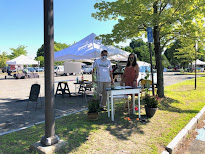https://www.nytimes.com/2020/06/24/style/mail-letters-coronavirus.htmlSnail Mail Is Getting People Through This Time
Letter writing has helped people meaningfully connect during this period of isolation, grief and unrest.

Laura Stanfill sent this watercolor-and-collage art piece to her friend Kathlene Postma, who gardens.Credit...Laura Stanfill
By Tove Danovich
June 24, 2020
Brianca Hadnot’s high school students in Houston started writing letters the day after George Floyd was killed.
“They felt unheard,” Ms. Hadnot, 30, said. “They can’t vote.”
As protests gained momentum around the country, she worried about them attending and possibly being tear gassed or shot with rubber bullets. Writing, she said, was another way the students could take action against police brutality.
“A letter is one of the most undervalued but important ways of expressing yourself,” said Ms. Hadnot, who teaches sophomore literature and writes under the name
Brianca Jay. “It doesn’t have to be perfect or written with the best grammar and semantics and flowery prose. It just has to be you.”
The students, with help from other community members, have written 75 letters so far, addressed to elected officials including local legislators and the president of the United States.
Snail mail has taken on
fresh resonance in this period of isolation, grief and unrest.
Sympathy cards are selling out as the coronavirus’s toll continues to rise. Constituents are mailing in primary election ballots and addressing handwritten notes to local officials with compliments and complaints. (In some cities, they
may also be sending letters to the police.) Many more are writing postcards to friends and loved ones, and calling for the United States Postal Service to be saved from its
dire financial straits.
First-class mail has been a declining category for the Postal Service for over a decade. It will be a few months before the service publishes statistics on mail volumes for April and May, but it did see “significantly higher product sales” of items including stamps in April, according to a representative. A
Postal Service survey whose results were published in May found that one in six consumers had sent more mail to family and friends during the pandemic.
Kenzie Myer, 21, said that she wasn’t a letter writer before the pandemic, which forced her to leave a study-abroad program in London and return to her home in Pennsylvania.
“I came back and hadn’t seen any of my friends from my home school,” Ms. Myer, a rising senior at Arcadia University, said. “I started sending them letters.” Most of them open with a disparaging line about her “garbage handwriting,” she said, then become more personalized.
For a friend whose 21st birthday passed in lockdown, she wrote about how she couldn’t wait to celebrate in person. For her partner, who lives in Australia, she writes “a lot of sappy stuff” and smears the page with roller-ball perfume. She posts her correspondents’ responses on her bedroom wall near her desk.
“Even though I can’t see the people that I love, they’re sending love back my way,” Ms. Myer said.

Henry, 4, punches out letters to friends and family on a typewriter he received for Christmas.
Justin Hodges, 46, moved to Chicago three years ago and soon received a postcard from a local candidate. “This was not some soulless mass production,” he said. “Someone took the time to spell my name correctly and draw stars and hearts. It’s more personal.”
Eventually Mr. Hodges, a former flight attendant and now self-described “stay-at-home cat dad,” started writing postcards for her campaign as a volunteer and then for an organization that encourages people in swing states to vote. Over the last month, he has written 500 postcards that will be sent to Wisconsin voters closer to the general election in November.
The coronavirus has made many people realize just how important the Postal Service is, Mr. Hodges said, even as it feels like it’s under siege. “We’ve gone to this online society, but letters encourage voter turnout and civic engagement. They’re warm and personal — tangible.”





















 Laura Stanfill sent this watercolor-and-collage art piece to her friend Kathlene Postma, who gardens.Credit...Laura Stanfill
Laura Stanfill sent this watercolor-and-collage art piece to her friend Kathlene Postma, who gardens.Credit...Laura Stanfill
